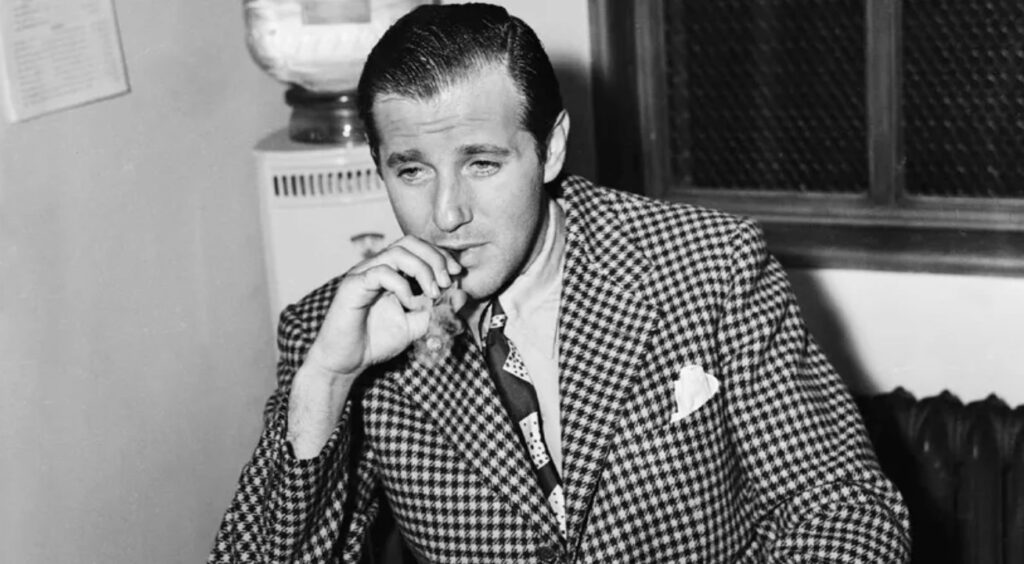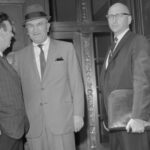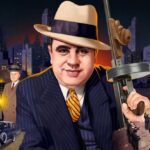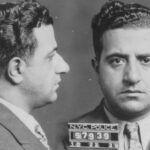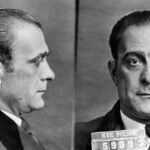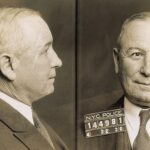Who Was Bugsy Siegel?
Benjamin “Bugsy” Siegel was a figure of contradictions, a man whose life was a labyrinth of complexities that defied easy categorization. Born into a Russian Jewish immigrant family in Brooklyn, New York, in 1906, Siegel’s early years were marred by financial hardship. This struggle for survival in the impoverished neighborhoods of Brooklyn shaped his worldview, instilling in him a relentless drive for success by any means necessary. His entry into the criminal underworld was not a casual descent but a calculated move to escape the clutches of poverty. By the tender age of 14, Siegel had not only formed his own gang but had also become a mastermind of extortion schemes. These early operations, which targeted vulnerable pushcart peddlers, were a harbinger of the audacious criminal enterprises that would later make him infamous. Siegel’s early life serves as a lens through which we can understand the motivations that propelled him into a life of crime. It wasn’t merely a quest for financial gain; it was a pursuit of power, status, and above all, recognition.
The Formation of a Criminal Empire
The trajectory of Siegel’s criminal career took a decisive turn when he crossed paths with Meyer Lansky, a like-minded individual with ambitions that mirrored his own. Their partnership was not just a meeting of minds but a fusion of complementary skill sets. Lansky was the strategist, the man who could dissect a problem and find a solution, while Siegel was the enforcer, the one who could get things done, no matter how perilous. Together, they founded the Bugs and Meyer Mob, an organization that would serve as the cornerstone of their criminal empire. This partnership eventually evolved into a pivotal role within a larger, more intricate network of organized crime groups known as the Syndicate. Comprising both Italian-American and Jewish-American factions, the Syndicate was a groundbreaking venture that revolutionized organized crime in America.
Siegel and Lansky’s criminal portfolio was as diverse as it was illicit. From bootlegging operations that capitalized on the Prohibition era’s thirst for alcohol to illegal gambling rings that exploited human vice, their enterprises were a study in opportunism. But perhaps their most chilling venture was the formation of “Murder, Inc.,” a cadre of contract killers responsible for executing the Syndicate’s dirty work. This wasn’t just a group of hitmen; it was a highly organized operation that employed a range of professionals, from drivers to lookouts, each playing a specific role in the execution of a hit. The formation of “Murder, Inc.” was a testament to Siegel and Lansky’s ingenuity in institutionalizing violence, making it a service that could be both efficient and profitable. Their role in establishing this lethal arm of the Syndicate underscores their influence in shaping the landscape of organized crime in America.
The Volatile Temperament of Bugsy Siegel
The volatility that earned Siegel his nickname “Bugsy” was not just a personality quirk; it was a strategic tool that he wielded with calculated precision. While it’s true that Siegel had a quick temper and was prone to violent outbursts, these traits served a purpose in the criminal underworld. His reputation for volatility made him a formidable opponent, one who could not be easily manipulated or intimidated. It was a form of social currency that added to his mystique and power. Yet, this volatile nature was a double-edged sword. On one hand, it made him feared; on the other, it made him a target for both law enforcement and rival gangsters. Interestingly, Siegel was acutely aware of the impact of his nickname and detested it. He insisted on being called “Ben” by his friends and “Mr. Siegel” by those who didn’t know him well. This insistence on formal titles was not just a matter of personal preference; it was an attempt to distance himself from the “Bugsy” persona and present himself as a legitimate businessman.
The West Coast Adventure – From New York to Los Angeles
Siegel’s relocation to Los Angeles in the mid-1930s was not merely a change of scenery; it was a strategic expansion of his criminal empire. The City of Angels offered a fertile ground for Siegel’s diverse criminal ventures, from gambling dens to offshore gambling ships and narcotics trade routes. But what set Siegel apart from other mobsters was his ability to navigate both the criminal underworld and the glamorous world of Hollywood with equal finesse. His presence at exclusive Hollywood parties was not just for leisure; it was a calculated move to build alliances with influential figures in the entertainment industry. Names like Clark Gable and Cary Grant were not just celebrities to Siegel; they were potential business partners and shields against public scrutiny. Siegel’s ability to straddle these two disparate worlds speaks volumes about his adaptability and strategic acumen. He understood that power and influence were not confined to the criminal underworld; they permeated every facet of society, including the glitzy world of Hollywood.
The Birth of a Dream – The Flamingo Hotel in Las Vegas
Siegel’s vision for Las Vegas was not just ambitious; it was revolutionary. At a time when Las Vegas was a far cry from the bustling entertainment hub it is today, Siegel saw untapped potential. His dream of building a luxurious hotel and casino was not just about creating a profitable business; it was about transforming the very fabric of the city. With financial backing from the Syndicate, Siegel took charge of the Flamingo Hotel project, a venture fraught with challenges and setbacks. The original budget of $1.5 million ballooned to an astronomical $6 million, not just due to Siegel’s mismanagement but also because of his refusal to compromise on quality. From the architecture to the interior design, every aspect of the Flamingo was meticulously planned to cater to the rich and famous. Despite the initial financial losses, the Flamingo eventually turned a profit, validating Siegel’s vision and audacity. However, this success came at a steep price. His inability to keep the project within budget made him a liability in the eyes of the Syndicate, setting the stage for his eventual downfall.
The Downfall – Betrayal and Death
The abrupt termination of Siegel’s life on June 20, 1947, was not just a personal tragedy but a seismic event that sent shockwaves through the criminal underworld and beyond. Gunned down in the Beverly Hills home of his girlfriend, Virginia Hill, Siegel’s murder was a grim testament to the precariousness of power in organized crime. While the identity of his killer remains a subject of speculation, the timing and circumstances of his death point to a chilling reality: Siegel had become expendable to the very organization that he helped build. On the night of his murder, three associates of Meyer Lansky walked into the Flamingo Hotel and announced a takeover. This brazen act, executed within hours of Siegel’s death, was not just a corporate reshuffling; it was a public disavowal, a clear message from the Syndicate that Siegel’s reign had come to an end. The swiftness with which the Syndicate moved to erase Siegel’s influence underscores the ruthlessness of organized crime, where loyalty is often a fleeting commodity, traded for the promise of power and profit.
The Legacy of Bugsy Siegel
Siegel’s influence on Las Vegas transcends the brick-and-mortar edifice of the Flamingo Hotel. His audacious vision for the city was a catalyst that accelerated its transformation from a nondescript desert town into a global entertainment capital. While Siegel was not the first to see the potential of Las Vegas, he was among the first to act on it, to stake his reputation and resources on a dream that many considered foolhardy. The Flamingo Hotel, despite its rocky start and the scandal that surrounded its construction, became a foundational element in the city’s evolution. It was more than a hotel and casino; it was a statement of intent, a declaration that Las Vegas could be a sanctuary for those seeking the extraordinary. Siegel’s legacy is not just in the physical structures he left behind but in the aspirational ethos that he instilled in Las Vegas—an ethos that continues to draw millions to the city in search of escape, excitement, and the elusive promise of a life less ordinary.
Unsolved Mysteries and Theories
The enigma of Bugsy Siegel extends beyond the life he lived to encompass the mystery surrounding his death. Despite exhaustive investigations and a plethora of theories, the question of who killed Siegel remains unanswered, adding a layer of intrigue to an already complex narrative. Some theories point to Meyer Lansky, Siegel’s long-time friend and criminal associate, as the mastermind behind the hit. This theory gains traction when considering the immediate takeover of the Flamingo Hotel by Lansky’s associates on the night of Siegel’s death. Others suggest alternative explanations, ranging from romantic entanglements gone awry to business rivalries that reached a deadly climax. Each theory adds a new dimension to the Siegel enigma, complicating our understanding of a man who defied easy categorization. The unsolved nature of his murder serves as a fitting epilogue to a life marked by contradictions and complexities. It ensures that Siegel, even in death, remains an object of fascination, a puzzle that invites endless scrutiny but defies definitive solution.
In Popular Culture – The Man, The Myth, The Movies
The allure of Bugsy Siegel’s life has proven irresistible to filmmakers and documentarians alike, making him a recurring subject in the realm of popular culture. The 1991 film “Bugsy,” featuring Warren Beatty in the titular role, stands as perhaps the most iconic representation of Siegel on the silver screen. Yet, these cinematic adaptations serve a dual purpose: they both immortalize and distort the man. While they amplify his larger-than-life persona, they also contribute to the muddling of historical facts, often opting for dramatic flair over factual accuracy. This tension between myth and reality in Siegel’s cinematic portrayals is not merely a byproduct of artistic license; it’s a reflection of the enigmatic nature of Siegel himself. The films become a lens through which society grapples with the complexities of a man who was both a criminal mastermind and a social chameleon. Thus, Siegel’s presence in popular culture serves as an ongoing dialogue between the man he was and the legend he has become, a dialogue that enriches our understanding of both.
Intriguing Facts About Bugsy Siegel
The Fashion-Forward Gangster
Bugsy Siegel was not just any run-of-the-mill gangster; he was a man of style. In an era where most mobsters were content with functional attire, Siegel chose to stand out. He was often seen in custom-made suits, silk ties, and two-tone shoes. His sartorial choices were not just for vanity; they were a calculated move to present himself as a sophisticated entrepreneur rather than a common criminal. This attention to detail extended to his grooming habits, making him one of the most well-dressed figures in the criminal underworld and Hollywood social circles alike.
The Hollywood Connections
While it’s known that Siegel mingled with Hollywood’s elite, what’s less discussed is the depth of these relationships. He didn’t just attend parties; he formed close friendships with some of the biggest names in the industry. Actors like George Raft and studio executives like Harry Warner were not just acquaintances but allies who provided Siegel with a level of social protection. These relationships also allowed him to venture into legitimate businesses, blurring the lines between his criminal activities and mainstream society.
The Innovator in Crime
Siegel was a pioneer in organized crime, introducing methodologies that were ahead of his time. For instance, he was among the first to understand the value of diversifying criminal enterprises. While many mobsters of his era focused solely on one type of illegal activity, Siegel spread his risks and rewards across bootlegging, gambling, and even the narcotics trade. This business acumen made him an invaluable asset to the Syndicate, even as it made him a target for law enforcement agencies.
The Family Man
Contrary to his public image as a ruthless mobster, Siegel was a family man. He married his childhood sweetheart, Esta Krakower, in January 1929, and they had two daughters, Millicent and Barbara. Despite his criminal activities and frequent liaisons with other women, Siegel maintained a semblance of family life. His marriage eventually ended in divorce, largely due to his infidelity, but the fact remains that he tried to balance domestic life with his criminal endeavors, a duality that adds another layer to his complex personality.
The Intellectual Interests
Siegel was not just muscle and firepower; he had a mind that was keenly interested in various subjects. Sources indicate that he had a library in his home, filled with books on subjects ranging from philosophy to engineering. While there’s no evidence to suggest that he was a scholar, his interest in intellectual pursuits sets him apart from the stereotypical mobster, offering a glimpse into the mind of a man who was constantly seeking to expand his horizons.
The Philanthropic Endeavors
One of the lesser-known aspects of Siegel’s life was his involvement in charitable activities. He was known to have funded several initiatives, particularly those aimed at helping impoverished children. While some might argue that these acts were designed to launder his ill-gotten gains, there’s no denying that they had a positive impact on the community. This juxtaposition of criminality and philanthropy makes Siegel’s character all the more enigmatic.
The Love for High-Stakes Gambling
Siegel was a gambler, but not just any gambler. He was known for his love of high-stakes games, often wagering astronomical sums. This penchant for gambling was not just a pastime; it was a reflection of his risk-taking personality. Whether it was betting on a horse race or investing in a new venture like the Flamingo Hotel, Siegel was a man who thrived on taking chances, for better or for worse.
Final Thoughts
Bugsy Siegel’s life was a labyrinth of paradoxes, a complex tapestry woven from threads of audacity, vision, brutality, and charm. His criminal enterprises were as groundbreaking as they were ruthless, setting new paradigms in the underworld even as they shattered lives. Yet, his social agility allowed him to penetrate Hollywood’s inner sanctum, where he was not an outsider but a welcomed guest. This duality—of being both a feared criminal and a charismatic socialite—adds layers of complexity to the public persona that Siegel crafted for himself. His influence on Las Vegas is not merely a footnote in his biography but a defining chapter that encapsulates his relentless ambition. Even in death, Siegel defies simplification. The myriad theories that swirl around his murder serve as a testament to the enduring enigma that he remains.
In examining the life of Bugsy Siegel, we are not merely exploring the biography of an individual but navigating a complex narrative that intersects with pivotal moments in American history. From the dark alleys of Prohibition-era crime to the neon-lit streets of Las Vegas, Siegel’s life is a microcosm of a nation in flux, grappling with its own contradictions and potentials. His story is not just a tale of personal ambition and downfall; it’s a narrative that reflects the broader social and cultural currents of his time. As such, the enigma of Bugsy Siegel remains as compelling today as it was during his lifetime, a subject of endless fascination that continues to provoke questions, ignite debates, and inspire interpretations across multiple platforms and disciplines.

